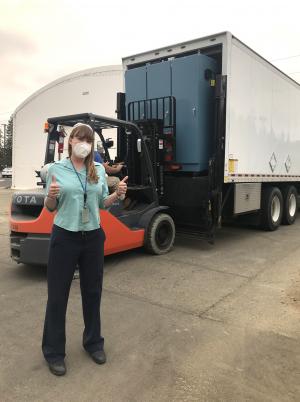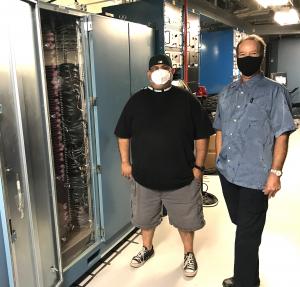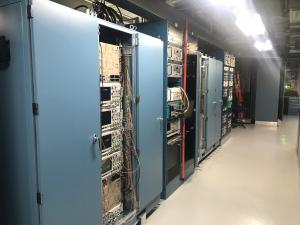Diagnostic capability allows scientists to create X-ray movies
Lawrence Livermore National Laboratory (LLNL) scientists are working on a new diagnostic capability that will provide, for the first time, the ability to make X-ray radiographic movies.
The first experiment testing the principle, dubbed the Bipolar Reset Experiment (BIRX), was conducted at LLNL’s Flash X-Ray (FXR) deep-penetration radiographic facility at Site 300. The team has been focusing on accelerating the FXR electron beam using active reset induction cells driven by bipolar solid-state pulsers.
Nathaniel Pogue, accelerator physics group leader in LLNL’s National Security Engineering Division, said the experiment demonstrated the first time that a solid-state pulsed-power system has been used to accelerate (provide energy gain), to kiloamps of electron beam. It also is the first time that a bipolar solid-state pulsed-power (BSSPP) system has been used to accelerate kiloamps of electron beam. This shows rapid growth and maturation of the bipolar pulsed-power technology and accelerator hardware, as well as the ingenuity and resourcefulness of the LLNL team.
“This work will allow scientists to create X-ray movies of items of interest with each frame being 10s to 100s of nanoseconds apart once a full accelerator is made,” he said, adding that each beam pulse acts as a frame in the movie.
Katherine Velas gives the thumbs-up as the pulser is loaded onto a truck for transportation to LLNL’s Site 300.
These movies would allow researchers working on hydrodynamic experiments to gather 5 to 10 times more images and data than current capabilities. This will provide much more information with fewer experiments, enhancing the capabilities to support the National Nuclear Security Administration’s stockpile stewardship program.
The team conducted the experiment by developing two bipolar cells that were inserted into the FXR beamline. The team then connected two cells to four BSSPP systems that provided the energy to the cells. When the FXR was fired, the power from the BSSPP was pushed into the cells, which then produce a high voltage across its gap to accelerate the FXR beam.
Pogue said an energy analyzer measured the difference in energy, showing that the energy was transferred from the pulser to the beam via the cell. FXR has two modes, single-pulse and double-pulse.
The key point of the experiment beyond the use of solid-state pulsed-power to accelerate kiloamps of beam for the first time, is that the cells were fired to accelerate the first pulse from FXR and are depleted. In between the first pulse and second pulse from FXR, a reset pulse is sent to the cells, effectively replenishing them or restoring them to be ready to accelerate again. When the second FXR pulse comes, the system is able to accelerate again. This novel technology allows for the ability to reset or replenish the cells in between pulses or frames — allowing for a large amount of frames — or a movie.
Brian Marquez and Alan Hill check out the first installed pulser.
The next step in the project is to finish the design of a test injector that is currently underway and construct the test injector at LLNL. This will help demonstrate an integrated system using this technology that can produce a beam as well as accelerate it. The goal is to have this step completed within the next two years.
Team members that contributed to the success of the BIRX project include Jennifer Ellsworth, Pogue, Katherine Velas, Steve Falabella, Brian Marquez, Alex Lo, Brendan Riordan, Alan Hill, Joe Lown, Gilbert Rentaria, Will Stem, Gregg Holtmeier, Saeed Assadi, Ed Cook, Craig Brooksby, Blake Kreitzer, Don Anderson, Kyle Berry, Kenneth Boyden, Ruben Cahayag, Cas Casados, Yazmin Cervantes, Vernon Chase, Eric Clark, Dorene Dodd, Pat Duffy, Steve Kenitzer, Donald Koen, Edward Koh, David Layne, Robert Lemon, Nicholas Lum, Jian Ma, Andrew Martino, Brent McHale, Brittany McKim, Kevin Person, Chris Postrero, Salvador Robles, Ronald Shaw, Ernesto Tellez Larios, Alan Teruya, Diana Thai, Steve Vernon, Rochelle Vu and Jim Watson.
The pulsed power installed at LLNL’s Flash X-Ray (FXR) deep-penetration radiographic facility at Site 300.
Contact
 Michael Padilla
Michael Padilla
[email protected]
(925) 341-8692
Related Links
Site 300Tags
Global SecurityLasers and Optical S&T
Lasers
National Ignition Facility and Photon Science
Science
Strategic Deterrence
Featured Articles











